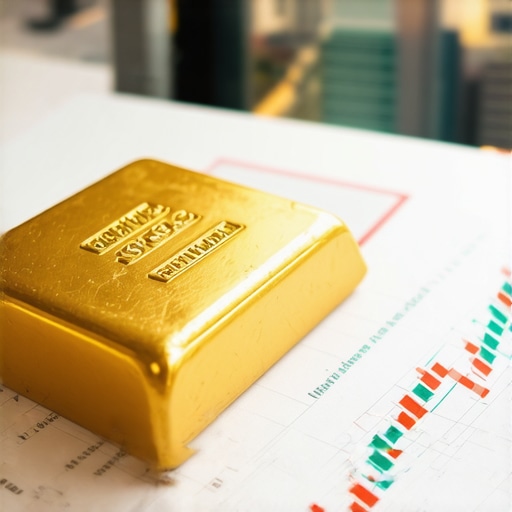Introduction to Gold ETFs and Their Importance in Investment Portfolios
Gold exchange-traded funds (ETFs) have become increasingly popular among investors looking to diversify their portfolios with precious metals. These investment vehicles offer a practical way to invest in gold without the need to physically hold the metal. Understanding Gold ETFs is essential for both new and experienced investors, as they provide unique features and benefits that can enhance your investment strategy.
What Are Gold ETFs?
A Gold ETF is a type of exchange-traded fund that tracks the price of gold. It is designed to provide investors with exposure to the gold market without the complexities of buying, storing, and insuring physical gold. When you invest in a Gold ETF, you are essentially purchasing shares that represent a specific amount of gold, typically stored in secure vaults. This structure allows for easy trading on stock exchanges, making Gold ETFs a convenient option for investors.
Key Features of Gold ETFs
Gold ETFs come with several key features that make them appealing to investors:
- Liquidity: Gold ETFs can be bought and sold like stocks throughout the trading day, providing high liquidity and the ability to react quickly to market changes.
- Cost-Effective: Investing in Gold ETFs often incurs lower fees compared to purchasing and storing physical gold, making them an economical choice for many investors.
- Transparency: Most Gold ETFs regularly disclose their holdings and the amount of gold they own, allowing investors to track their investments easily.
- Diversification: Gold ETFs can be included in a broader investment strategy, helping to diversify portfolios and mitigate risks associated with market fluctuations.
Benefits of Investing in Gold ETFs
Investing in Gold ETFs offers several benefits that can enhance your overall investment strategy:
- Hedge Against Inflation: Gold has historically been viewed as a safe-haven asset during times of economic uncertainty and inflation. By including Gold ETFs in your portfolio, you can protect your investments against the eroding effects of inflation.
- Accessibility: Gold ETFs provide an accessible entry point for investors who may not have the capital or desire to invest in physical gold. This democratization of gold investment opens opportunities for a wider range of investors.
- Tax Efficiency: In many jurisdictions, Gold ETFs can be more tax-efficient than physical gold investments, as they may be subject to lower capital gains tax rates.
Understanding the features and benefits of Gold ETFs is crucial for making informed investment decisions. As they continue to gain traction among investors seeking to capitalize on gold’s potential, being well-informed can help you navigate the complexities of this investment vehicle.
Why Choose Gold ETFs Over Physical Gold?
When considering investment options in gold, many investors find themselves at a crossroads between Gold ETFs and traditional physical gold holdings. While physical gold, such as bullion or coins, offers tangible security, Gold ETFs present a range of practical benefits that can enhance your investment experience.
Convenience and Ease of Transaction
One of the most significant advantages of Gold ETFs is their convenience. Investors can easily buy and sell shares through online brokerage accounts, making transactions swift and hassle-free. Unlike physical gold, which requires storage and insurance, Gold ETFs eliminate the logistical challenges associated with managing physical assets. This ease of transaction allows for more agile investment strategies, enabling investors to respond quickly to market movements.
Lower Costs of Entry
Investing in Gold ETFs often incurs fewer upfront costs compared to purchasing physical gold. The expenses associated with buying, storing, and insuring gold can quickly add up, while Gold ETFs often have lower management fees. This cost-effectiveness means that even smaller investors can participate in the gold market without significant financial barriers, allowing for greater inclusivity in gold investment.
Understanding the Role of Gold ETFs in Diversified Portfolios
Incorporating Gold ETFs into a diversified investment portfolio can be a strategic move for both novice and seasoned investors. Gold ETFs serve as a hedge against market volatility and economic downturns, making them an essential component of a balanced investment approach.
Diversification Benefits
Gold inherently has a low correlation with other asset classes, such as stocks and bonds. This unique characteristic means that including Gold ETFs in your portfolio can reduce overall risk. During periods of economic uncertainty, gold prices often rise as investors seek safe-haven assets. By diversifying with Gold ETFs, you can potentially stabilize your portfolio’s performance during turbulent market conditions.
Long-Term Investment Strategy
For investors looking at long-term growth, Gold ETFs can be an effective tool. Historical trends show that gold generally retains its value over time, making it a reliable asset for wealth preservation. Furthermore, as the demand for gold continues to rise, driven by factors such as technological advancements and increased consumption in emerging markets, Gold ETFs can offer significant capital appreciation potential.
How to Select the Right Gold ETF for Your Investment Needs
Choosing the right Gold ETF involves considering several factors that align with your investment goals and risk tolerance. Here are key aspects to evaluate:
Expense Ratios and Management Fees
Reviewing the expense ratios of Gold ETFs is crucial, as lower fees can enhance your overall returns. Even a small difference in fees can significantly impact your investment performance over time. Compare several Gold ETFs to find the ones with competitive expense ratios that still provide robust management and performance.
Fund Performance and Tracking Error
Analyze the historical performance of Gold ETFs, focusing on how closely they track the price of gold. A lower tracking error indicates that the ETF is effectively mirroring gold prices, which is essential for achieving your investment objectives. Look for funds with a proven track record of performance and stability.
In conclusion, Gold ETFs offer a myriad of advantages, making them an attractive option for investors seeking to diversify their portfolios. By understanding the unique features of these funds and how they fit into your overall investment strategy, you can harness the potential of gold to enhance your financial future.
Evaluating Gold ETFs: Key Considerations for Investors
When diving deeper into the world of Gold ETFs, it’s essential to evaluate several key considerations that can significantly impact your investment strategy. By understanding these elements, you can make informed decisions that align with your financial objectives.
Liquidity and Trading Volume
Liquidity is a critical factor to consider when choosing a Gold ETF. Higher trading volumes often indicate better liquidity, allowing investors to enter or exit positions more easily without affecting the market price significantly. Look for Gold ETFs that consistently exhibit high trading volumes, as this can enhance your overall investment experience.
Tax Implications of Gold ETFs
Understanding the tax implications associated with Gold ETFs is vital for maximizing your returns. Unlike physical gold, which is often subject to higher capital gains tax rates, Gold ETFs may benefit from more favorable tax treatment in certain jurisdictions. Investors should consult with tax professionals to fully grasp how these investments can impact their tax liabilities.
Strategies for Investing in Gold ETFs
Implementing effective investment strategies is crucial for successfully navigating the Gold ETF landscape. Here are several strategies to consider:
Dollar-Cost Averaging
Dollar-cost averaging is a strategy that involves investing a fixed amount of money into Gold ETFs at regular intervals, regardless of the market price. This approach can help mitigate the effects of volatility and reduce the average cost per share over time. By consistently investing in Gold ETFs, you can capitalize on market fluctuations and potentially increase your returns.
Using Gold ETFs for Hedging
Gold ETFs can serve as a valuable hedging tool against inflation and market volatility. By incorporating Gold ETFs into your portfolio, you can protect your investments from economic downturns and currency fluctuations. This strategic use of Gold ETFs not only diversifies your holdings but also enhances your overall risk management approach.
Monitoring Gold Market Trends
Staying informed about gold market trends is essential for any investor looking to maximize the potential of Gold ETFs. Understanding the factors that influence gold prices can help you make timely investment decisions. Key trends to monitor include:
Global Economic Indicators
Economic indicators, such as inflation rates, interest rates, and geopolitical events, play a significant role in driving gold prices. Regularly analyzing these indicators can provide insights into market movements and help you anticipate potential price changes for Gold ETFs. For instance, during periods of high inflation, gold is often viewed as a safe-haven asset, leading to increased demand and higher prices.
Central Bank Policies
The actions of central banks, particularly in major economies, can significantly impact gold prices. Monitoring central bank policies regarding gold reserves can offer clues about future price movements. For example, if a central bank increases its gold holdings, it may signal confidence in gold as a stable asset, potentially driving prices higher.
Conclusion: Harnessing the Power of Gold ETFs
In conclusion, Gold ETFs offer a flexible and efficient way to invest in gold while providing numerous advantages over traditional physical gold. By evaluating factors such as liquidity, tax implications, and employing effective investment strategies, you can harness the power of Gold ETFs to enhance your investment portfolio. For more insights on maximizing your investment in gold, consider exploring resources like tips from experienced dealers and understanding Gold IRAs to make informed decisions that align with your financial goals.
Advanced Strategies for Capitalizing on Gold ETFs
As investors delve deeper into the realm of Gold ETFs, employing advanced strategies can significantly enhance potential returns. Understanding market dynamics and leveraging various techniques can position investors to make the most of their gold investments.
Leveraging Market Insights for Timing
Effective timing is crucial when investing in Gold ETFs. Monitoring market sentiments and trends can be pivotal. Utilizing tools such as market analysis reports and gold price forecasting can provide insights into optimal times to buy or sell. For example, during economic uncertainty, gold often experiences a surge in demand, making it a prime target for investment.
Utilizing Sector Rotation Strategy
The sector rotation strategy involves shifting investment focus among different sectors based on economic cycles. Investors can apply this principle to Gold ETFs by increasing exposure during periods of economic downturn when gold often appreciates in value. This proactive approach ensures that investors capitalize on market trends effectively.
Incorporating Gold Futures for Enhanced Returns
For those willing to take on more risk, incorporating gold futures into an investment strategy can amplify returns. By taking positions in gold futures contracts, investors can benefit from price fluctuations without needing to hold physical gold. However, it’s essential to understand the risks involved, as futures trading can lead to significant losses if market conditions shift unexpectedly.
Evaluating Gold ETFs: Performance Metrics
When assessing Gold ETFs, it’s important to evaluate performance metrics that can help gauge their effectiveness. Here are some key metrics to consider:
Expense Ratios and Fees
The expense ratio reflects the costs associated with managing the ETF, and lower fees generally lead to better long-term performance. Investors should compare the expense ratios of different Gold ETFs to ensure they are not sacrificing returns to high management costs. Understanding these fees is essential for maximizing investment efficiency.
Tracking Error Analysis
Tracking error measures how closely an ETF follows the performance of its benchmark index. A low tracking error indicates that the ETF accurately reflects the price movements of gold. Investors should scrutinize this metric to ensure their Gold ETFs are performing as expected, avoiding significant deviations that could hinder returns.
Building a Diversified Gold Investment Portfolio
Diversification is a cornerstone of successful investing, and this principle holds true for Gold ETFs as well. By incorporating a range of gold-related investments, including Gold ETFs, physical gold, and gold mining stocks, investors can spread risk and enhance potential returns. This diversified approach allows investors to capitalize on different aspects of the gold market.
Combining Gold ETFs with Other Asset Classes
Integrating Gold ETFs into a broader investment portfolio that includes stocks, bonds, and alternative investments can help stabilize returns. Gold often behaves differently than other asset classes, providing a hedge against market volatility and inflation. This diversification can bolster overall portfolio performance, making Gold ETFs an integral part of a well-rounded investment strategy.
Conclusion: Strategic Investment in Gold ETFs
In summary, adopting advanced strategies and understanding key performance metrics are vital for investors looking to maximize their potential returns with Gold ETFs. By leveraging market insights, evaluating performance, and diversifying investments, individuals can navigate the complexities of the gold market effectively. For further exploration of how to enhance your gold investment strategy, check out our comprehensive guide on understanding gold coins and top gold trading strategies that can complement your Gold ETF investments.
Frequently Asked Questions About Gold ETFs
What are Gold ETFs and how do they work?
Gold ETFs, or exchange-traded funds, are investment funds that track the price of gold. They allow investors to gain exposure to gold without having to physically buy or store the metal. Investors can buy shares of a Gold ETF on stock exchanges, and each share represents a certain amount of gold.
Why should I invest in Gold ETFs?
Investing in Gold ETFs offers several benefits, including liquidity, ease of trading, and diversification. They can act as a hedge against inflation and economic uncertainty, providing a safe haven for investors during turbulent market conditions.
What factors influence the price of Gold ETFs?
The price of Gold ETFs is primarily influenced by the current market price of gold. Other factors include economic data, interest rates, inflation, and geopolitical events. Understanding these factors can help investors make informed decisions regarding their investments in Gold ETFs.
Are Gold ETFs a safe investment?
While Gold ETFs are generally considered a safer investment compared to physical gold due to lower storage and insurance costs, they still carry market risks. Investors should assess their risk tolerance and consider diversifying their portfolio to mitigate potential losses.
How do I choose the best Gold ETF?
When selecting a Gold ETF, consider factors such as expense ratios, tracking error, liquidity, and the fund’s performance history. It’s essential to conduct thorough research and compare different options to find the ETF that aligns with your investment goals.
Can I hold Gold ETFs in a retirement account?
Yes, many Gold ETFs can be held in tax-advantaged accounts like IRAs. This allows investors to potentially benefit from tax-deferred growth while investing in gold. Always consult with a financial advisor to ensure compliance with retirement account regulations.
What are the tax implications of investing in Gold ETFs?
Investing in Gold ETFs can have tax implications similar to other investments. Depending on your country’s tax laws, profits from the sale of Gold ETF shares may be subject to capital gains tax. It’s advisable to consult a tax professional to understand how these rules apply to your situation.
How can I buy Gold ETFs?
Gold ETFs can be purchased through a brokerage account just like stocks. Investors can place buy orders online, and once the order is executed, they will own shares of the ETF. It’s crucial to choose a reputable brokerage that offers access to a variety of Gold ETFs.
What are the risks associated with Gold ETFs?
Some risks of investing in Gold ETFs include market volatility, tracking errors, and potential liquidity issues. Investors should be aware of these risks and consider their investment horizon and financial goals before investing.
Authority Resources for Gold ETF Investors
To further enhance your understanding of Gold ETFs and investment strategies, consider exploring the following trusted resources:
- SPDR Gold Shares – A leading Gold ETF provider with comprehensive information about gold investments.
- iShares Gold Trust – Another prominent Gold ETF, offering insights into the gold market and investment strategies.
- World Gold Council – Provides extensive research and reports on gold investment trends and market analysis.
- Kitco News – A trusted source for gold news, prices, and market analysis.
- Investopedia – Offers articles and guides on Gold ETFs, investment strategies, and market insights.
Conclusion: Embracing the Gold ETF Opportunity
Gold ETFs present a unique opportunity for investors seeking to diversify their portfolios and hedge against economic uncertainties. By understanding the intricacies of these investment vehicles, employing advanced strategies, and leveraging performance metrics, individuals can optimize their gold investments. Remember to stay informed by utilizing reputable resources and continuously evaluating your investment strategy. With the right knowledge and approach, Gold ETFs can be a powerful addition to your investment arsenal.










